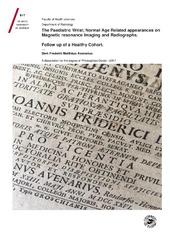| dc.contributor.advisor | Rosendahl, Karen | |
| dc.contributor.author | Avenarius, Derk | |
| dc.date.accessioned | 2017-11-07T07:53:49Z | |
| dc.date.available | 2017-11-07T07:53:49Z | |
| dc.date.issued | 2017-09-27 | |
| dc.description.abstract | A cohort of 89 healthy children was recruited from Tromsø during 2009. All children had a radiograph and an MRI of the left wrist, while 74 met for a follow-up study during 2013. The initial examination showed that all children had numerous bony depressions in one or more of the carpal bones, and that these depressions could mimic erosions as defined in the adult rheumatoid arthritis literature, and other diseases seen in children. Moreover, around half of the children had at least one joint with more than 2 mm joint fluid, as well as bone marrow oedema-like changes in at least one of the carpal bones.
In the 4-year follow-up we added a cartilage-specific MR-sequence to better characterize bony depressions.
The results of the follow-up resembled those found during 2009, namely that the number of bony depression increased with age, that around one third had bone marrow oedema like changes in at least one of the carpal bones, and that half had joint fluid pockets deeper than 2 mm. Moreover, bone marrow oedema like changes were found in different areas as compared to the initial examination in 2009, it occurred on both sides of a joint and in close relation to ganglion cysts.
Four out of ten bony depressions were covered by cartilage with a decreasing percentage by age group.
The presence and number of ganglion cysts were examined for both the baseline and the follow-up examinations. One or more ganglion cyst were found in one fourth of the children/adolescents included in both assessments, with six having disappeared during the 4-year period and eleven having appeared.
In conclusion, bony depressions, bone marrow oedema like changes, and ganglion cysts represent normal findings and should not be interpreted as disease without additional markers for arthritis being present. A cartilage-sensitive sequence adds information that might be helpful in differentiating bony surface irregularities during maturation from true destructive change. | en_US |
| dc.description.doctoraltype | ph.d. | en_US |
| dc.description.popularabstract | 89 healthy children were recruited from Tromsø. All children had a radiograph and an MRI of the left wrist taken, while 74 met for a follow-up study. Both examination showed that all children had numerous findings that could mimic different diseases seen in children. Joint fluid was seen in half of the children, as well as bone marrow oedema-like changes in at least one of the carpal bones. It was shown that the number of bony irregularities increased with age, and that bone marrow oedema like changes were found in different areas as compared to the initial examination, it occurred on both sides of a joint and in close relation to ganglion cysts. One or more ganglion cyst were found in one fourth of the children included. In conclusion, bony irregularities, bone marrow oedema like changes, and ganglion cysts can represent normal findings and should not be interpreted as disease without additional markers for disease being present. | en_US |
| dc.description.sponsorship | department of radiology at the university hospital of north Norway
helse-Nord hrf | en_US |
| dc.description | The papers of this thesis are not available in Munin. <br>
Paper I: Müller, L. S., Avenarius, D., Damasio, B., Eldevik, O. P., Malattia, C., Lambot-Juhan, K., Tanturri, L., Owens, C. M., Rosendahl, K.: “The paediatric wrist revisited: redefining MR findings in healthy children”. Available in <a href=http://dx.doi.org/10.1136/ard.2010.135244> Ann Rheum Dis. 2011, 70(4):605-10. </a>
<br>
Paper II: Avenarius, D. F., Ording Müller, L. S., Eldevik, P., Owens, C. M., Rosendahl, K.: “The paediatric wrist revisited - findings of bony depressions in healthy children on radiographs compared to MRI”. Available in <a href=http://dx.doi.org/10.1007/s00247-012-2354-x> Pediatr Radiol. 2012, 42(7):791-8. </a>
<br>
Paper III: Avenarius, D. F., Ording Müller, L. S., Rosendahl, K.: “Erosion or normal variant? 4-year MRI follow-up of the wrists in healthy children”. Available in <a href=http://dx.doi.org/10.1007/s00247-015-3494-6> Pediatr Radiol. 2016, 46(3):322-30. </a>
<br>
Paper IV: Avenarius, D. F., Ording Müller, L. S., Rosendahl, K.: “Joint fluid, bone marrow oedema like changes and ganglion cysts in the paediatric wrist; features that may mimic pathology. Follow-up of a healthy cohort”. Available in <a href=http://dx.doi.org/10.2214/AJR.16.17263> AJR Am J Roentgenol. 2017, 23:1-6. </a> | en_US |
| dc.identifier.uri | https://hdl.handle.net/10037/11702 | |
| dc.language.iso | eng | en_US |
| dc.publisher | UiT The Arctic University of Norway | en_US |
| dc.publisher | UiT Norges arktiske universitet | en_US |
| dc.rights.accessRights | openAccess | en_US |
| dc.rights.holder | Copyright 2017 The Author(s) | |
| dc.rights.uri | https://creativecommons.org/licenses/by-nc-sa/3.0 | en_US |
| dc.rights | Attribution-NonCommercial-ShareAlike 3.0 Unported (CC BY-NC-SA 3.0) | en_US |
| dc.subject | VDP::Medical disciplines: 700::Clinical medical disciplines: 750::Radiology and diagnostic imaging: 763 | en_US |
| dc.subject | VDP::Medisinske Fag: 700::Klinisk medisinske fag: 750::Radiologi og bildediagnostikk: 763 | en_US |
| dc.title | The Paediatric Wrist; Normal Age Related appearances on Magnetic Resonance Imaging and Radiographs.
Follow up of a Healthy Cohort | en_US |
| dc.type | Doctoral thesis | en_US |
| dc.type | Doktorgradsavhandling | en_US |


 English
English norsk
norsk
